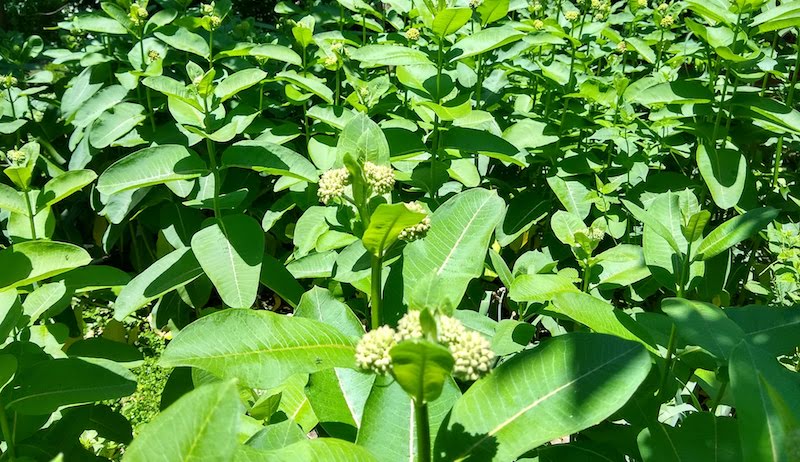
I purchased a real fixer-upper of a house a couple of years ago. Out front was one inexplicably empty flowerbed. The rest of my half-acre was grass. Up and down the street, it was the same story. Lawns lay neatly mowed, some trees stood here and there, and that was it. Not exactly a paradise for pollinators.
Although I had much to do inside, I spent most of that first year replacing portions of my lawn with purple coneflower, black-eyed Susans, bee balm, sunflowers, yarrow and common milkweed (shown below). I added birdhouses, bird feeders, water sources, a solitary pollinator habitat and a beehive.
Soon, the neighbors noticed “new” birds, butterflies, bumblebees and other pollinators flitting by. The woman next door even asked, “Do you think we could get some bluebirds?” (We did!)
Humans Working Together Helps
By now, most people have heard that honeybees and monarch butterflies are in trouble, but bumblebees, moths, bats, songbirds and countless other valuable pollinators are imperiled, too. Increasingly fragmented landscapes, reliance on pesticides and even air pollution are part of the problem. Fortunately, we can do a lot to be part of the solution. And when we act together? We’re even more effective.
See, some pollinators pick up on different flowers’ visual cues, but floral scent compounds, in particular, are what draw in most insects. According to a 2016 study published in the journal Atmospheric Environment, “[E]ven moderate air pollutant levels … substantially degrade floral volatiles and alter the chemical composition of released floral scents.” As a result, it can take foraging pollinators much longer to find available food. This, in turn, can affect their health and their ability to reproduce.
Bigger Is Better
We can help counteract this phenomenon by planting large areas in the same type of pollinator-attracting plant. In other words? Rather than interspersing my black-eyed Susans in the same small bed with my bee balm, I can plant a 3-by-3-foot block in all bee balm. I can add similarly large groupings of purple coneflower, borage and so on, in order to boost the distinct scent released by each specific floral patch.
And when my neighbors start to do likewise? We’ve got the makings of a much larger, pollinator-attracting corridor. (After all, property lines don’t matter much to birds, bats or bees.)
What to Plant
Ready to try this in your own neighborhood? Because the plants will provide area pollinators with optimal sources of pollen and nectar, opt for native, open-pollinated (rather than hybridized) perennials when possible. Also, certain pollinators are especially attracted to particular types of corresponding flowers. (For instance, bats are attracted to white, green or purple flowers, which release their fragrance in the evening.)
Which plants are best-suited for your neighborhood pollinator corridor depends on your climate and location. If you’re in the U.S. or Canada, you can enter your postal code here to download a free, comprehensive planting guide for your region. (There is also a related smartphone app.) U.S. residents can also consult their state or regional native plant society.
Recruiting the Neighbors
While some neighbors might already want to help pollinators, others might not care in the least. Freely offering extra seeds and plants—even labor!—are great ways to get some folks on board. Others might be swayed by the opportunity to expose their kids or grandkids to their first wild canary or tiger swallowtail butterfly.
Sometimes making an economic case can help. While it’s true that pollinator gardens might need regular watering at first, once they’re established, they require little care. Having lots of native plantings also means less time—and money—needs to be spent mowing the lawn.
Case in point: After planting wildflowers on 1,000 acres of roadside, the Florida Department of Transportation reported an increase of “almost $15 million worth of pollination and beneficial insect services.” The Florida DOT also estimated it saved more than half a million dollars on reduced mowing and “weed control from intact ecosystems.”
Start With Small Steps
Despite your best efforts, you might still have a few neighborhood holdouts. If they seem open to suggestions, ask them to avoid using insecticides. You might also have them consider mowing a little less frequently or raising the deck on the lawnmower by a quarter of an inch or so. (This enables pollinator-sustaining clover, dandelions and violets to flourish.)
No matter what, don’t be pushy, but do bring fresh flowers from time to time. These can help keep things cordial—and keep future lines of communication open.




